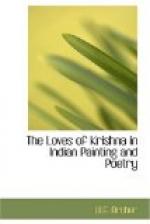The second result is the allegorical interpretation which Krishna’s romances now received. In Christian literature, the longing of the soul for God was occasionally expressed in terms of sexual imagery—the works of the Spanish mystic, St. John of the Cross, including ’songs of the soul in rapture at having arrived at the height of perfection which is union with God.’
Oh night that was my guide!
Oh darkness dearer than the morning’s
pride,
Oh night that joined the lover
To the beloved bride
Transfiguring them each into the other.
Within my flowering breast
Which only for himself entire I save
He sank into his rest
And all my gifts I gave
Lulled by the airs with which the cedars
wave.[50]
This same approach was now to clarify Radha’s romance with Krishna. Radha, it was held, was the soul while Krishna was God. Radha’s sexual passion for Krishna symbolized the soul’s intense longing and her willingness to commit adultery expressed the utter priority which must be accorded to love for God. If ultimate union was symbolized by romantic love, then clearly nothing could approach such love in ultimate significance. In deserting their husbands and homes and wilfully committing adultery, Radha and the cowgirls were therefore illustrating a profound religious truth. Not only was their adultery proof of Krishna’s charm, it was vital to the whole story. By worldly standards, they were committing the gravest of offences but they were doing it for Krishna who was God himself. They were therefore setting God above home and duty, they were leaving everything for love of God and in surrendering their honour, were providing the most potent symbol of what devotion meant. This approach explained other details. Krishna’s flute was the call of God which caused the souls of men, the cowgirls, to forsake their worldly attachments and rush to love him. In removing the clothes of the cowgirls and requiring them to come before him naked, he was demonstrating the innocent purity with which the soul should wait on God. In himself neglecting Radha and toying with the cowgirls, he was proving, on one level, the power of worldly pleasures to seduce the soul but on another level, the power of God to love every soul irrespective of its character and status. From this point of view, the cowgirls were as much the souls of men as Radha herself and to demonstrate God’s all-pervasive love, Krishna must therefore love not only Radha but every cowgirl. Equally, in the circular dance, by inducing every cowgirl to think that she and she alone was his partner, Krishna was proving how God is available to all. Finally it was realized that even those portions of the story which, at first sight, seemed cruel and callous were also susceptible of religious interpretation. When Radha has been loved in the forest and then is suddenly deserted, the reason is her pride—pride that because Krishna has loved her, she can assert




